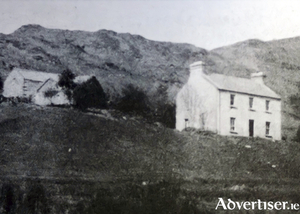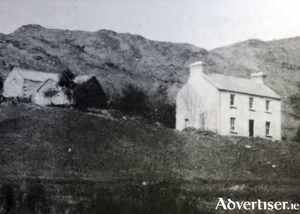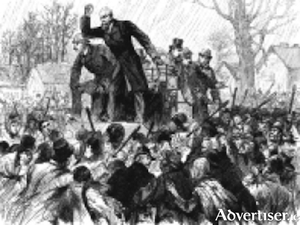Search Results for 'Kathleen Villiers-Tuthill'
19 results found.
O’Loughlin’s cavalry protected the king

The arrival of British royalty on Irish shores in recent times, is usually greeted with genuine interest and curiosity, and a sense of welcome and respect, while extreme nationalists have to grin and bear it.
The legend of the last battle in Connemara

During the war of Independence the West Connemara IRA brigade, under the command of Petie McDonnell, was an effective and disciplined force. It had moved its headquarters to the Muintir Eoin residence of Pádraic Mór Ó Máille, a two-storey farmhouse, backed by rock and heather covered hills, which stood on a small rise, along the Maam to Leenane road. It offered commanding views of the Maam Valley.
The legend of the last battle in Connemara

During the war of Independence the West Connemara IRA brigade, under the command of Petie McDonnell, was an effective and disciplined force. It had moved its headquarters to the Muintir Eoin residence of Pádraic Mór Ó Máille, a two-storey farmhouse, backed by rock and heather covered hills, which stood on a small rise, along the Maam to Leenane road. It offered commanding views of the Maam Valley.
The Shawl of Galway Grey
The murderous and vengeful events that followed 'Bloody Sunday' 1920 impacted on the town of Clifden in an unexpected way. There was shooting and murder on its streets; and, following a rampage by the Black and Tans, practically half the town was burnt down.
‘It is not our mistress we have lost, but our mother.’

When Mitchell Henry entered Westminster parliament in 1871 he went with hope in his heart and a mission to tell the British people the circumstances of the Irish tenant farmer. He reminds me of the Frank Cappa film Mr Smith Goes to Washington where a naive, idealistic young man has plans to change America.* Mitchell Henry, a liberal, kindly man, had however, walked into a political cauldron, waiting to explode.
A fantasy of romantic days of yore

It must have been an extraordinary sight in the 1860s to see Kylemore castle rise from a bog in the heart of Connemara’s Twelve Pins, barely a decade following the devastation of the Great Famine. More than 100 men were employed, at a handsome wage of seven to 10 shillings a week, turning rough, soggy land, only good for shooting wild fowl and for fishing in its nearby lakes, into a magnificent building. Today it stands more like a palace than a castle, and is still a show-stopper on the Letterfrack road.
‘Beyond our wildest expectations’
Week III
‘Beyond our wildest expectations’
Week III


